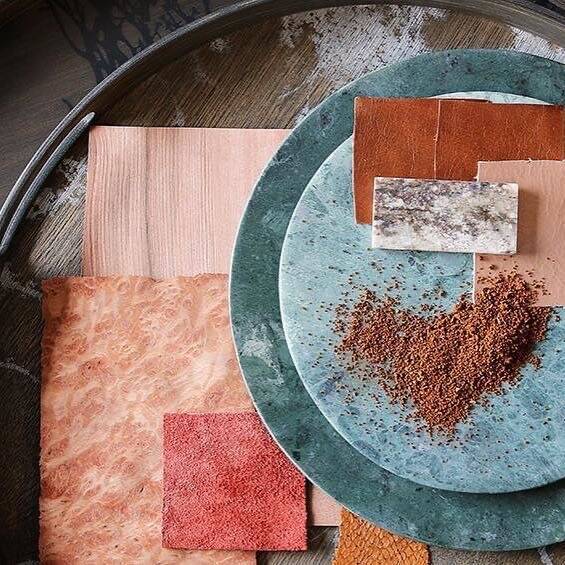Environmental protection and healthy living are becoming more and more closely related, with people paying more attention to fitness exercise in the office, healthy eating, green building, frugal design, waste reduction and reasonable sharing of resources taking root, and sustainable design becoming an important trend in the future of professional clothing. "According to data from the International Energy Agency and the World Wide Institute for Nature, it can be seen that the textile industry in fact accounts for only 0.7% of the world's total carbon emissions, less than 400 million tonnes." Hu Kehua, Deputy Director of the Social Responsibility Office of the China Textile Industry Federation and Director of the Sustainable Development Programme, said.

I. Sustainable thematic colours
With the increasing pressure in the workplace nowadays, people are increasingly looking forward to living close to nature and feeling the original environment, and colours are also more inclined towards natural and sustainable. The forest and the earth are a natural palette, and the original shades of pine cones, bush browns and pumpkin colours are close to nature with artificial colours such as phantom grey and sky blue, in line with the modern urban lifestyle of being keen on nature and caring for the environment.
Fig.1 trend 2017: an earthy colour palette for interior design
II. Sustainable clothing materials
Environmentally friendly clothing materials have the advantages of non-polluting production, degradable, recyclable, energy-saving, low loss and harmless to the human body, which can effectively reduce the pollution caused to the environment during the production process. With the increasing emphasis on health and environmental protection products, the promotion and application of "green" environmental protection vocational clothing is imperative.
- Organic cotton
Organic cotton is a pure natural non-polluting cotton, in agricultural production, organic fertilizer, biological control of pests and diseases, natural farming management, does not allow the use of chemicals, in the production of spinning process also requires no pollution; with ecological, green, environmental characteristics; organic cotton woven into the fabric lustrous and bright, soft to the touch, with a good rebound force, drape, wear resistance; has a unique anti-bacterial, anti-odour Good breathability, suitable for shirts and professional wear
Certifications: USDA-Certified Organic, Global Organic Textile Standard (GOTS), Organic Content Standard (OCS), Better Cotton Standard, Fair Trade, Bluesign, Oeko-Tex 100 - Recycled cotton
Recycled cotton is produced from post-industrial or post-consumer waste. Used by many slow fashion brands, this means that your favourite cotton underwear or sustainable jeans are made from industrial waste or other recycled cotton clothing.
Certifications: Global Recycle Standard (GRS), Recycled Content Standard (RCS), Oeko-Tex 100 - Organic Hemp
Hemp is one of the most environmentally friendly natural fabrics. It is highly productive, good for the soil and it requires much less water than cotton. It is considered to be a carbon-negative raw material, absorbing carbon dioxide from the atmosphere. Because it has so many benefits (such as natural sun protection and antibacterial properties) and is more difficult to grow, hemp tends to be slightly more expensive than other sustainable, organic fabrics.
Certifications: USDA-Certified Organic, Global Organic Textile Standard (GOTS), Organic Content Standard (OCS), Oeko-Tex 100, Bluesign - Organic linen
Linen is almost identical to hemp in terms of sustainability. The fabric is ultra-light and breathable, the only difference being that linen is derived from the flax plant. It requires very little fertiliser, pesticides and irrigation to grow. However, unlike hemp, flax is not produced in large quantities.
However, linen is still relatively universally popular, and textiles ranging from linen clothing to linen bed linen mean it is one of the most popular fabrics.
Certifications: USDA-Certified Organic, Global Organic Textile Standard (GOTS), Organic Content Standard (OCS), Oeko-Tex 100, Bluesign - Organic bamboo (bamboo linen)
When harvesting bamboo, this can be done without killing the plant itself. This means that bamboo can be renewed very quickly and is also one of the fastest growing plants on the planet. Like hemp, bamboo consumes more CO2 than some trees. And it doesn't require a lot of input either, surviving closely on rainfall.
Organic bamboo can turn out to be one of the most sustainable fabrics, but that doesn't mean it's always the case. Depending on how it is processed, it can involve chemically intensive processes and the harmful effects that entails. Mechanical processing is noted as a more environmentally friendly way of doing things, but only accounts for a small percentage of the market.
Certifications: Forest Stewardship Council, USDA-Certified Organic, Global Organic Textile Standard (GOTS), Organic Content Standard (OCS), Fair Trade, Oeko- Tex 100, Bluesign
6. Cork fabrics
Cork fabric has left the board and bottle out of the stereotype and is now close to our clothes. This material has become a popular material for vegan bags and shoes. The cork is harvested from the cork oak tree by scraping off the bark.
Certifications: Forest Stewardship Council, USDA-Certified Organic, Global Organic Textile Standard (GOTS), Organic Content Standard (OCS), Fair Trade, Oeko- Tex 100, Bluesign

Fig.2 Textile Sourcing from muscogeemills

Fig.3 Retal Outlet -Tienda de telas para decoración

Fig.4 Cloth house JAD SAND
III. Why we do sustainable fashion
The garment industry has an irreversible impact on the environment in terms of production, while overproduction results in unconsumable garments that are like rubbish. Therefore, we must now be socially responsible to address and reduce the pollution caused by clothing.
Sustainability is a bigger theme and direction, and we present it in many ways and visions. For example, zero waste tailoring, we often concentrate on the use of materials, but the waste rate of fabrics is actually 15 per cent, so if we can reduce fabric loss, how is that not a contribution to sustainability?

Fig.5 Via @fash_rev Instagram

Fig.5 Photographed by Ugur Gallenkus Artworks
List Of Illustrations
Fig.1.trend 2017: an earthy colour palette for interior design [Online].Available at:https://www.londonessentials.com/2017/03/27/trend-2017-an-earthy-colour-palette-for-interior-design/
Fig.2.Textile Sourcing from muscogeemills [Online].Available at:https://www.muscogeemills.com
Fig.3.Retal Outlet -Tienda de telas para decoración [Online].Available at:https://retaloutlet.com
Fig.4.Cloth house JAD SANDhttps[Online].Available at:https://www.clothhouse.com/products/natural-dyed-jad-sand
Fig.5. Via @fash_rev Instagram[Online].Available at: https://www.fashionroundtable.co.uk/news/2020/10/6/1uyghur-crisis-why-is-the-fashion-industry-repeatedly-implicated-in-modern-slavery-scandals
Fig.6.Photographed by Ugur Gallenkus Artworks[Online].Available at:https://www.saatchiart.com/account/artworks/1315483
Add comment
Comments